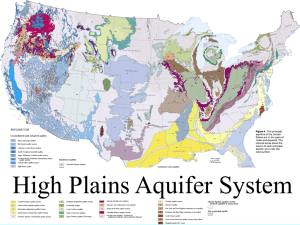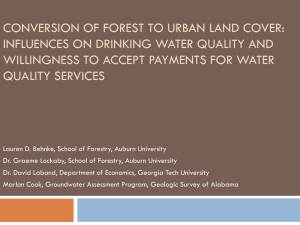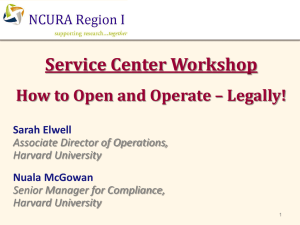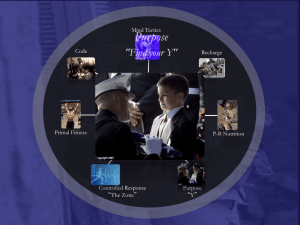Income and Recharge Policies and Procedures Training
advertisement
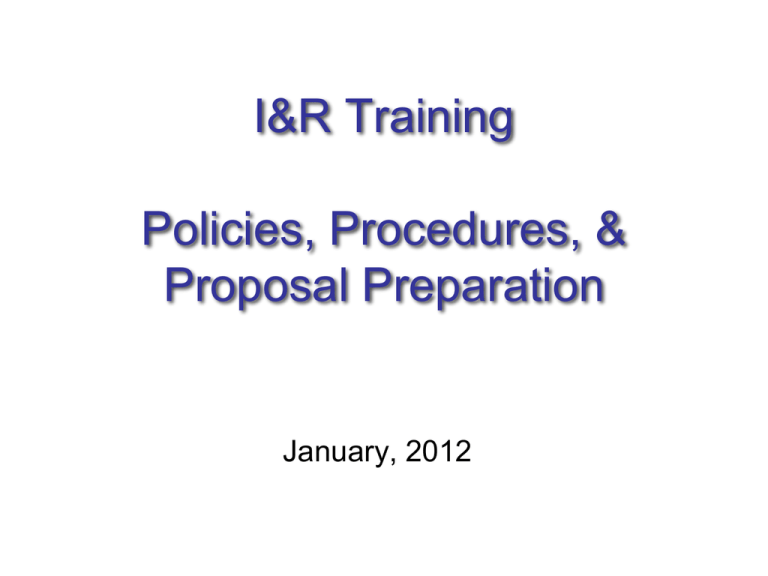
I&R Training Policies, Procedures, & Proposal Preparation January, 2012 Agenda 1. 2. 3. 4. 5. 6. 7. 8. Income & Recharge Introduction Functional Responsibilities Types of Review Rate Development Steps Managing a Recharge Center Proposal Preparation Questions and Common Issues References and Contact Information I&R Training Introduction University departments provide goods and services that are not “core funded”, and therefore must charge for those services Clients may be campus departments, students, faculty, staff, and/or general community Charges to campus departments = RECHARGE Charges to outside groups = INCOME I&R Training Campus Review Required by Federal and University policies to review and approve rates charged for goods and services To insure consistent costing procedures are used throughout the campus Insures that departments & control points actually review their self-supporting activities I&R Training TYPE 1 RECHARGE 1. The cost charged to one department for specific goods or services by another department. Includes auxiliary and services enterprises, academic department support units, plant services Most recharges fall into this category Examples: copy services, use of research equipment, automobile rentals I&R Training TYPE 2 RECHARGE • The cost charged to self-supporting activities that are primarily funded from external income for identifiable services provided by central campus administrative offices • Example: NSFAS, Accounting charging Housing for payroll services. I&R Training TYPE 3 RECHARGE The cost charged to a department for special services by a central campus administrative office, beyond normal services provided Example: Human Resources provides a broad range of services to the campus free of charge, and also provides training classes for a fee I&R Training DEPARMENTAL ROLES • • • • Overall operation of the recharge center Compliance with all University policies and procedures Reviews the budget, revenue, expenses,and services provided on an ongoing basis Preparation and submittal of annual rate review package to the control point and Budget Office in a timely manner I&R Training CONTROL POINT ROLE • Oversees and assists with the operation of recharge units • Reviews and endorses all new rates, rate revisions and self-certification forms prior to submission to the Budget Office • Reviews and concurs with any surplus/deficit reduction plan I&R Training I&R COMMITTEE ROLE • Oversees the Income and Recharge process • Approves the establishment of all new recharge units • Approves Rate Revision and On-Cycle reviews • Reviews and approves all surplus/deficit reduction plans I&R Training BUDGET OFFICE ROLE • • • • • Provides the Chair to the Income & Recharge Committee and ongoing staff support to the committee Acts in an advisory capacity to recharge centers and departments Reviews rate proposals (approves Self-Certification Reviews Provides training to the campus community Provides ongoing fiscal review of the University’s recharge operations I&R Training ACCOUNTING & AUDIT ROLE • Provides general accounting assistance to recharge units, including assignment of object codes, fund set up, accounting for inventory and depreciation & reserves • Provides assistance on tax issues such as Unrelated Business Income Tax and sales tax • Provides training to the campus community I&R Training REVIEW TYPES After a new rate for goods or services has been established, an annual review must be submitted to the Budget Office through the control point Self-Certification Review Rate Revision Review On-Cycle Review I&R Training SELF-CERTIFICATION REVIEW • No new goods or services • No change in costing methodology or business practices • No personnel or salary changes beyond those authorized or anticipated by the University • Review and approval delegated to the Budget Office I&R Training RATE REVISION REVIEW • New rates requested due to changes in costing methodology, business practices, or personnel are different from those authorized or anticipated by the University. • Review by Income and Recharge Committee I&R Training ON-CYCLE REVIEW Depends on volume of unit’s recharge activity: • Income is greater than $200K/year - a complete review every 3rd year • Income is between $50K and $200K/year - a complete review every 5th year • Income is less than $50K/year - no On-Cycle Review; the annual Self-Certification Review is sufficient Reviewed by Income and Recharge Committee I&R Training RULES & CRITERIA • • • • • Funding for the service is not part of the department permanent budget A specifically identifiable good or service is provided Services are unique or specialized Services are provided to multiple departments on a regular, ongoing basis Separate costs and budgets must be clearly defined for the activity I&R Training RULES & CRITERIA • • • • Services provided should not be readily available from outside sources. If they are, there must be overriding economic or ethical issues requiring the University to provide these services. All campus users are charged the same rate for the same services provided Recharge centers must only charge their published, approved rates Units should operate on a break-even basis I&R Training RULES & CRITERIA • Services can be provided to non-campus, nonaffiliated entities only if they are unique and support the campus’s academic mission. Rates charged to these entities should be fully costed and include the campus’s indirect cost surcharge. • All rates must be reviewed annually. Review may be in the form of Self-Certification, On-Cycle Review, or Rate Revision Review I&R Training RATE CRITERIA • • • • • • Must cover full cost of the operation. May also include indirect costs. Must be reasonable Should be developed to break even Must be consistently charged May be subsidized “Deterrent Fees” - late fees, rush fees - may be charged with proper justification I&R Training DIRECT COSTS • Include all direct costs - all allowable direct costs of providing the product or service should be included in the recharge pool • Costs are identifiable - they can be identified specifically with a recharge product or service • Costs need to be reasonable - is the cost generally recognized as necessary for the operation? I&R Training DIRECT COSTS • Costs need to be treated consistently • Costs are reasonably allocable - must be able to assign a cost, or a group of costs, to the recharge pool in reasonable and realistic proportion that reflects the benefit provided I&R Training ALLOWABLE COSTS Allowable costs include: • • • • • • • Salaries, wages and fringe benefits Supplies and services Maintenance and repair of equipment Equipment depreciation Administration costs of the recharge unit Lease costs of non-University owned space Prior year operating surplus/deficit that occurred through the normal course of business I&R Training UNALLOWABLE COSTS A-21 unallowable costs (e.g., entertainment, memberships, donations & contributions, advertising, bank card fees, bad debts, legal fees, fines & penalties) • • Costs of capitalized improvements Exceptional charges that did not occur through the normal course of business (e.g., costs related to non-recover of recharge income due to department not billing recharge customers in accordance with University billing procedures) I&R Training EQUIPMENT Inventorial equipment is a stand-alone item with a useful life greater than one year and a value greater than $5,000 Federal guidelines do not allow the purchase cost of equipment to be charged directly to the recharge activity. Equipment must be funded from some other source (e.g., equipment reserves, general funds, gift funds, or other unrestricted fund sources) I&R Training EQUIPMENT DEPRECIATION • Equipment should be depreciated on a straight-line basis • Useful life tables can be found at: http://eulid.ucop.edu • Depreciation must begin in fiscal year that equipment is purchased • See Dale O’Donnell in Accounting if equipment will be depreciated I&R Training EQUIPMENT DEPRECIATION Depreciation expense is included as a cost in the rate development except when: • Equipment is funded by the federal government • Equipment is identified as cost sharing to a federal research project I&R Training RATE SUBSIDIES • Subsidies fund a portion of the recharge unit’s total costs, which results in lower rates Multiple subsidies are allowed Non-campus users should be charged unsubsidized rates Subsidies may be used to: • • • • • • Offset expenses of the recharge activity Pay for specifically identified purchases Reduce the price for all University users or specific products or services I&R Training ALLOCATING JOINT COSTS • Departments that have more than one service unit may have joint costs that apply to some or all of the units • The joint costs should be allocated to the units on a basis that reflects the benefit to the unit • Common bases for allocating joint costs: • • • • FTE Chargeable labor hours Hours of machine usage Assignable square footage I&R Training RESERVES • Make appointment to see Dale O’Donnell in Accounting - dale.odonnell@accounting.ucsb.edu • Rates that include equipment should have a depreciation reserve I&R Training MANAGING RECHARGE CENTERS Recharge Center Budgets Customer Relations and Consultations Billing Deficits and Surpluses Reserves Equipment Purchases I&R Training RECHARGE CENTER BUDGETS • All recharge departments must have a permanent budget that reflects projected revenue and expense • Permanent budgets must be revised at the end of the fiscal year to account for the anticipated changes and be reflected in the July 1 Adjusted Budget • Work with Arliene Shelor in the Budget Office to establish or update the permanent budget I&R Training CONSULTATION WITH USERS • Recharge providers must notify customers as early as possible of proposed rate changes (This should happen when the Rate Revision Review is submitted) • Departments should have in place a process to determine customer satisfaction, which should be documented in the rate proposal package • Approved rates for goods and services should be posted and readily available to potential and current users (e.g., on a web site, in the department office) I&R Training BILLING • Recharge unit may not bill in advance of providing goods or services • Departments need to bill their customers in a timely manner: • No longer than 45 days after goods or services have been delivered, or • No longer than 45 days after recharge center has been billed by third party providing goods or services I&R Training BILLING • Recharge unit must use correct account/fund/sub as provided by customer • External users must be billed through BARC • May only bill customers using approved rates I&R Training DEFICITS & SURPLUSES • Recharge center should operate on a break-even basis Surplus: general fund balance greater than 30 days operating expense Deficit: general fund balance deficient by greater than 30 days operating expense • A unit that is out of tolerance must develop a “recovery plan” to bring it back into range within 3 months of being notified by Accounting Office or Budget Office I&R Training DEFICITS & SURPLUSES • Recovery plan must be put in place to eliminate surplus or deficit within three years • Plan needs to be reviewed and endorsed by Control Point before it is forwarded to Budget Office • If plan requires a rate change, a Rate Revision Review must be completed I&R Training PROPOSAL PREPARATION 1. Identify lines of business 2. Pool costs along lines of business 3. Identify means of distributing costs 4. Estimate usage 5. Develop rates I&R Training GENERAL RATE CALCULATION • In its most simple form, a recharge rate is calculated by dividing the total cost of providing the goods or services by the total projected activity Total Budgeted Expense Rate = (Plus Prior Year Deficit, or Minus Prior Year Surplus) Total Projected Level of Activity for the Budget Period I&R Training RATE CALCULATIONS • • • • • Productive Time Calculation Recharge Personnel Hourly Rate Calculations Sample Rate Calculation - Labor Sample Rate Calculation - Mark-Up Sample Rate Calculation - Production • • Calculation and Revenue & Expenses Summary Sample Rate Calculation - Rental • Calculation and Revenue & Expenses Summary I&R Training THE RATE PACKAGE • • • • • • • • Transmittal Memo Rate Proposal Cover Sheet A - Description of Goods and Services B - Customer Information C - Summary of Individual Rates D - Proposed Budget E - Actual Expense and Revenue Summary F - Equipment Depreciation I&R Training QUESTIONS I&R Training REFERENCES • • • • • University of California Business and Finance Bulletin A-47, University Direct Costing Policy University of California Business and Finance Bulletin A-56, Academic Support Unit Costing and Billing Guidelines University of California Business and Finance Bulletin A-59, Costing and Working Capital for Auxiliary and Service Enterprises OMB Circular A-21, Cost Principles of Educational Institutions July 14, 1993 letter from University Controller Joseph A. Pastrone to Administrative Vice Chancellors regarding “New Recharges to Federal Grants and Contracts” I&R Training CAMPUS CONTACTS BUDGET OFFICE Todd Lee X2169 todd.lee@bap.ucsb.edu Arliene Shelor X4052 arliene.shelor@bap.ucsb.edu Jim Corkill X5882 jim.corkill@accounting.ucsb.edu Dale O’Donnell X2998 dale.odonnell@accounting.ucsb.edu X2829 wandalynn.riley@audit.ucsb.edu ACCOUNTING OFFICE AUDIT SERVICES Wanda Lynn Riley I&R Training


